The gaseous envelope of Jupiter does not have a uniform distribution contrary to what has been previously known, according to an international team of astronomers led by Yamila Miguel (SRON/Leiden Observatory).
The interior sections of Jupiter have more metals than the outer parts, amounting to between 11 and 30 earth masses, or 3-9% of Jupiter's total mass, and the researchers said that it could indicate the planet's origins!

Metals Inside Jupiter
When NASA's Juno spacecraft landed on Jupiter in 2016, we were treated to a stunning view of our solar system's largest planet. Jupiter, in addition to the iconic Great Red Spot, is riddled by hurricanes, emulating the appearance and wonder of a Van Gogh artwork.
However, the planet's envelope behind the thin visible layer is not immediately discernible. Even so, Juno can create an image for us by detecting the gravitational force above several Jupiter sites. This provides astronomers with information on the planet's internal composition, which differs from what is perceived on the surface.
The gaseous envelope is not as homogeneous and well-mixed as previously thought, according to an international team of astronomers led by Miguel.
The researchers claim that metals, heavier elements than hydrogen and helium-have a larger contraction toward the planet's center. The team employed a multitude of theoretical models that heed the observational limits measured by Juno to arrive at their conclusions.
Miguel's team looked at metal distribution because it reveals information about Jupiter's genesis. The metals are not evenly distributed throughout the envelope, with more of them present in the interior than in the exterior.
According to Miguel, a gas giant like Jupiter can acquire metals in two ways during its formation: small pebble accretion or larger planetesimals. She said that once a newborn planet reaches a certain size, it begins to eject pebbles.
"The richness of metals inside Jupiter that we see now is impossible to achieve before that. So we can exclude the scenario with only pebbles as solids during Jupiter's formation. Planetesimals are too big to be blocked, so they must have played a role," Miguel said in a statement.
Read Also : NASA Juno Releases Radio Emissions Triggered by Jupiter's 'Io,' the Volcanic Moon of the Gas Giant
Like a Boiling Water
Miguel and his colleagues claimed that heavy element enrichment continued during the gas accretion phase of Jupiter, which has crucial implications for the formation of large planets in our solar system and beyond, according to the team.
The idea that the inner half of the envelope has more heavy elements than the outer part indicates that the abundance declines in a gradient rather than being uniform across the envelope.
Miguel noted that we used to believe that Jupiter "has convection," similar to boiling water that mixes everything up.
"But our finding shows differently," she stated.
This article is owned by Tech Times
Written by Joaquin Victor Tacla
ⓒ 2025 TECHTIMES.com All rights reserved. Do not reproduce without permission.




